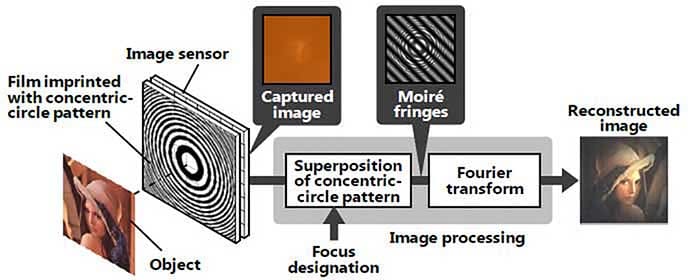Hitachi may be better known for its TVs and other audio-visual equipment, but soon the company plans to launch a camera that can capture video without using a lens and allow users to adjust the focus after footage has been recorded.
In essence, the camera works via a piece of film that sits over the sensor and translates light into a circular pattern.
The camera also employs an algorithm that helps the sensor reconstruct the image so that depth information in addition to planar information, can be reproduced at an arbitrary point of focus even after the image has been captured.
Here in its own words, Hitachi says the two main features of its lensless camera technology are:
01 Image processing technology using Moiré fringes
A film patterned with concentric circles (whose interval narrow toward the edge of the film) is positioned in front of an image sensor, and the image of a shadow formed by a light beam irradiated onto the film is captured by the image sensor.
During the image processing, a similar concentric-circle pattern is superimposed on the shadow and Moiré fringes with spacing dependent on the incidence angle of a light beam are formed. By utilizing the Moiré fringes, it is possible to capture images by simple and commonly used image processing called “Fourier transform”.
02 Focus adjustment technology of captured images
The focal position can be changed by changing the size of the concentric-circle pattern superimposed on the shadow formed on the image sensor by a light beam irradiated onto the film. By superposing the concentric-circle pattern by image processing after image capturing, the focal position can be adjusted freely.
To measure the performance of the developed technology, an experiment with a 1-cm2 image sensor and a film imprinted with a concentric-circle pattern positioned 1 mm from the sensor was conducted. The results of the experiment confirmed that video images could be captured at 30 frames per second when a standard notebook PC was used for image processing.
In plain English: the circular pattern on the piece of film that sits over the sensor records light similar to Lytro’s light field technology and – in theory – captures the depth of light within a scene. This allows users to change the point of focus after an image is captured.
However, Hitachi says it doesn’t intend to use the technology to replace traditional cameras like your or I use. Rather, the company is aiming to “utilize this technology in a broad range of applications such as work support, automated driving, and human-behavior analysis with mobile devices, vehicles and robots,” the company says.
In other words, Hitachi wants to use this technology to mount cameras on robots, self-driving cars and other tools and machines where in the past it hasn’t been possible to do so.
READ MORE
10 digital camera tips, tricks and truths you may not have known
Best mirrorless cameras in the world



